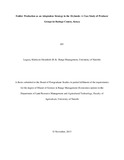| dc.description.abstract | Pastoral communities in Kenya are faced with many challenges chief of them recurrent and prolonged droughts which has triggered a number of responses aimed at enhancing resilience of pastoral households against such shocks. Fodder production is increasingly gaining popularity as a source of both livestock feed and income for pastoral households. In Baringo County, fodder production groups drawing membership from the community have been established with the aim of improving household livelihoods. This has however, been going on in the absence of empirical evidence to guide out-scaling of such approach. This study was carried out in Marigat Sub-County of Baringo County to map the fodder and grass seed value chain, determine its profitability based on gross margin and contribution to household income as well as factors that influence households’ participation in fodder production groups. Household interviews, focus group discussions and key informant interviews were used to gather data.
The results show that fodder producers were mainly composed of men, majority of whom had attained primary level education, and livestock keeping was their main occupation. Cenchrus ciliaris was the preferred grass species by the fodder producers due to its ability to easily establish, drought tolerance and it’s viable and easy to harvest seeds. Those involved in bulking and processing of grass seeds were found to be the dominant actors in the value chain. Besides buying grass seeds from producers, these agents provided inputs and ploughing services, and trained farmers. The individuals produced 28.13 kgs of seeds/acre while the groups produced 9.35 kgs/acre. A kilogram of grass seed was sold at an average price of Kshs. 250 by the fodder producers at the farm gate. However, the price varied depending on the quantity of grass seed offered for sale by a producer, the market outlet and the price negotiation skills of the producer whenever that option was available. Individual fodder producers made an average profit of Kshs. 1,088.60 per acre while the groups made a profit of Kshs. 474.48 per acre in the September to December fodder growing season of 2013. The leading sources of production costs were found to be ploughing and purchase of grass seed. Fodder production contributed about 5.71% of the monthly household income of individual producers compared to 0.42% for the group producers in the period under study (2013).
The results of the binary logit model show that households’ access to communal drought grazing reserves and their past bad experience with drought positively influenced their participation in fodder groups. The number of livelihoods pursued by a household, its herd size and the age of the household head negatively influenced membership to fodder production groups. Drought occurrences and low prices offered for grass seeds as well as failure of the existing market outlets to purchase grass seeds at times were found to be some of the challenges facing the fodder producers in the value chain. However, the findings of this study indicate that fodder production has the potential to address cash needs for pastoral households. The study recommends the need to link the fodder producers to reliable markets to cushion them from low prices offered for produced grass seeds. Also important is access to more input and service providers in the fodder and grass seed value chain to help lower the high prices of inputs associated with the current monopolistic nature of input market. Moreover, the current communal drought grazing reserves in pastoral areas should be sustained and expanded to complement fodder production efforts by households through provision of forage to sustain their herds during prolonged dry seasons and drought. | en_US |

